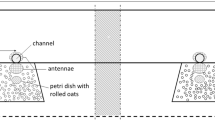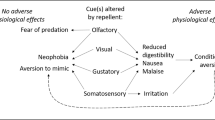Abstract
The effectiveness of predator odors (fecal and urine) in suppressing feeding damage by black-tailed deer was investigated in pen bioassays at the University of British Columbia Research Forest, Maple Ridge, British Columbia, Canada. A total of eight bioassay trials tested the effects of these odors on deer consumption of salal leaves and coniferous seedlings. Cougar, coyote,and wolf feces as well as coyote, wolf, fox, wolverine, lynx, and bobcat urines provided the most effective suppression of deer feeding damage. Novel odors of ammonia and human urine did not reduce feeding. Predator fecal odor formulations in direct foliar application, adhesive application, and in plastic vials were all effective in suppressing deer feeding. Of all urines tested, coyote provided the most consistent suppression of deer browsing on salal. Deer consumed significantly more untreated Douglas fir and western red cedar seedlings than those protected by coyote urine odor. The active repellent components of predator odors which suppress deer feeding may be suitable for encapsulation in controlled-release devices which could provide long-term protection for forest and agricultural crops.
Similar content being viewed by others
References
Anthony, R.G., andFisher, A.R. 1977. Wildlife damage in orchards—a need for better management.Wildl. Soc. Bull. 5:107–112.
Black, H.C., Dimock, E.J., Evans, J., andRochelle, R. 1979. Animal damage to coniferous plantations in Oregon and Washington—Part I. A survey, 1963–1975. Forest Research Laboratory, Oregon State University, Corvallis. Research Bulletin 25. 44 pp.
Brand, C.J., andKeith, L.B. 1979. Lynx demography during a snowshoe hare decline in Alberta.J. Wildl. Manage. 43:827–849.
Brodie, J.D., Black, H.C., Dimock, E.J., Evans, J., Kao, C., andRochelle, J. 1979. Animal damage to coniferous plantations in Oregon and Washington—Part II. An economic evaluation. Forest Research Laboratory, Oregon State University, Corvallis. Research Bulletin 16. 22 pp.
Crouch, G.L. 1976. Wild animal damage to forests in the United States and Canada.Int. Union For. Res. Org. Conf. 16:468–478.
Dodge, W.E., Loveless, C.M., andKverno, N.B. 1967. Design and analysis of forest-mammal repellent tests.For. Sci. 13:333–336.
Dzieciolowski, R., Szukiel, E. 1976. Vertebrate damage to the forests in central and eastern Europe.Int. Union. For. Res. Org. Conf. 16:515–527.
Gauditz, I. 1977. Bioassay methods guiding the development of a big game repellent, pp. 34–46,in W.B. Jackson and R.E. Marsh (eds.). Test Methods for Vertebrate Pest Control and Management Materials. American Society for Testing and Materials, Philadelphia.
Ghosh, R.C. 1976. Vertebrate damage to the forests in Asian countries.Int. Union For. Res. Org. Conf. 16:479–484.
Gilan, T. 1976. Damage done by vertebrates in western Europe.Int. U. For. Res. Org., Conf. 16:511–512.
Harestad, A.S., andJones, G.W. 1981. Use of nightcounts for censusing black-tailed deer on Vancouver Island, R.L. Miller and A. Gunne (eds.). Proceedings of the Symposium on Census and Inventory Methods for Populations and Habitats, pp. 83–96,in Wildlife Society, Washington.
Henessy, D.F., andOwings, D.H. 1978. Snake species discrimination and the role of olfactory cues in the snake-directed behavior of the California ground squirrel.Behavior 65:116–124.
Honachi, J.H., Kinman, K.E., andKoeppl, J.W. (eds.). 1982. Mammal Species of the World. Allen Press, Lawrence, Kansas.
Hoskinson, R.L., andMech, L.D. 1976. White-tailed deer migration and its role in wolf predation.J. Wildl. Manage. 40:429–441.
Keith, L.B., andWindberg, L.A. 1978. A demographic analysis of the snowshoe hare cycle.Wildl. Monogr. 58.
Lockley, R.M. 1964. The Private Life of the Rabbit. Transworld, London.
Longhurst, W.M., Oh, H.K., Jones, M.B., andKepner, R.E. 1968. A basis for palatability of deer forage.Trans. North Am. Wildl. Conf. 33:181–189.
Mech, L.D. 1977. Wolf pack buffer zones as prey reservoirs.Science 198:320–321.
Melchiors, M.A., andLeslie, C.A. 1984. Effectiveness of predator fecal odors as black-tailed deer repellents.J. Wildl. Manage. In press.
Müller-Schwarze, D. 1972. Responses of young black-tailed deer to predator odors.J. Mammal. 53:393–394.
Müller-Schwarze, D. 1974. Application of pheromones in mammals, pp. 452–454,in M.C. Birch (ed.). Pheromones. North Holland, Amsterdam.
Müller-Schwarze, D. 1983. Experimental modulation of behavior of free-ranging mammals by semiochemicals, pp. 235–244,in D. Müller-Schwarze and R.M. Silverstein (eds.). Chemical Signals in Vertebrates III. Plenum Press, New York.
Myllymaki, A. 1976. Damage by vertebrates in Scandinavian forestry.Int. Union For. Res. Org. Conf. 16:510.
Rogers, L.L., Mech, L.D., Dawson, D.K., Peek, J.M., andKorb, M. 1980. Deer distribution in relation to wolf pack territory edges.J. Wildl. Manage. 44:253–258.
Schwartz, C.C., Regelin, W.L., andNagy, J.G. 1980. Deer preference for juniper forage and volatile oil treated foods.J. Wildl. Manage. 44:114–120.
Stoddart, D.M. 1980a. The Ecology of Vertebrate Olfaction. Chapman and Hall, London. 234 pp.
Stoddart, D.M. 1980b. Some responses of a free-living community of rodents to the odors of predators, pp. 1–10,in D. Müller-Schwarze and B.M. Silverstein (eds.). Chemical Signals: Vertebrates and Aquatic Invertebrates. Plenum Publishing, New York.
Sullivan, T.P.,Nordstrom, L.O., andSullivan, D.S. 1985. Use of predator odors as repellents to reduce feeding damage by herbivores. I. Snowshoe hares (Lepus americanus).J. Chem. Ecol. 903–920.
Wilson, S.R., Carmack, M., Novotny, M., Jorgenson, J.W., andWhitten, W.K. 1978. Iso-pentenyl methyl sulfide. A new terpenoid in the scent mark of the red fox (Vulpes vulpes).J. Org. Chem. 43:4675–4676.
Author information
Authors and Affiliations
Rights and permissions
About this article
Cite this article
Sullivan, T.P., Nordstrom, L.O. & Sullivan, D.S. Use of predator odors as repellents to reduce feeding damage by herbivores. J Chem Ecol 11, 921–935 (1985). https://doi.org/10.1007/BF01012078
Received:
Accepted:
Issue Date:
DOI: https://doi.org/10.1007/BF01012078




